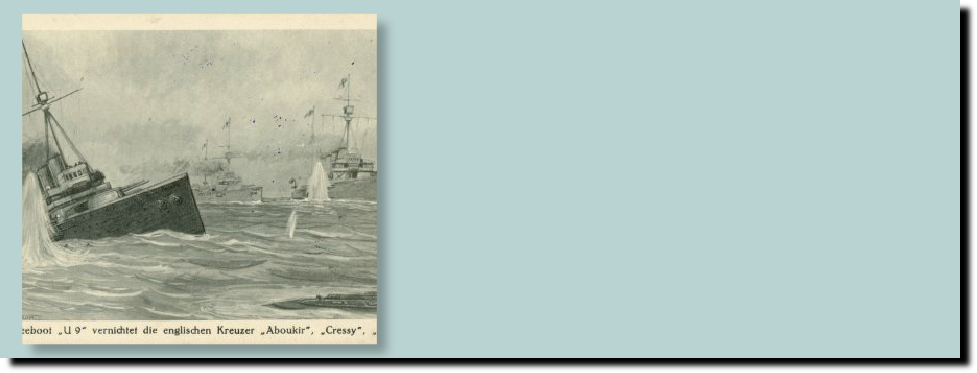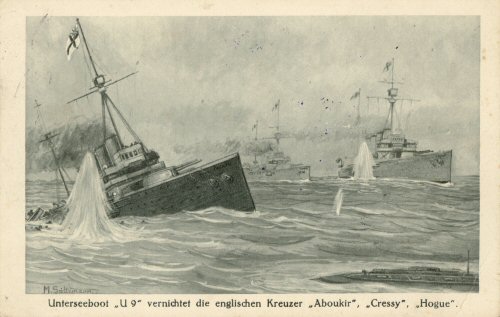
© Lindy and Martin Lovegrove 2012

During the early months of World War 1 the Royal Navy maintained a patrol of old Cressy class armoured cruisers, known as Cruiser Force C, in the area of the North Sea known as the Broad Fourteens. There was opposition to this patrol from many senior officers, including Admiral Jellicoe and Commodores Keyes and Tyrwhitt, on the grounds that the ships were very vulnerable to a raid by modern German surface ships and the patrol was nick named the "live bait squadron". The Admiralty maintained the patrol on the grounds that destroyers were not able to maintain the patrol in the frequent bad weather and that there were insufficient modern light cruisers available.
In the early hours of September 20th 1914 the cruisers HMS Euryalus, HMS Aboukir, HMS Hogue and HMS Cressy were preparing to go on patrol under Rear Admiral Christian in Euryalus. Normally the patrol was under command of Rear Admiral Campbell in HMS Bacchantes but he was absent so Christian helped fill the gap although he had other duties. The weather was too bad for destroyers to be at sea and unfortunately Euryalus had to drop out due to lack of coal and weather damage to her wireless, Rear Admiral Christian had to remain with his ship rather than transfer to another ship as the weather was too bad to transfer. He delegated command to Captain Drummond in Aboukir although he did not make it clear that Drummond had the authority to order the destroyers to sea if the weather improved, which it did towards the end of September 21st.
Early on September 22nd 1914 the German submarine U9 under the command of Commander Otto Weddigen sighted the Cressy, Aboukir and Hogue steaming NNE at 10 knots without zigzagging. Although the patrols were supposed to maintain 12-13 knots and zigzag the old cruisers were unable to maintain that speed and the zigzagging order was widely ignored as there had been no submarines sighted in the area during the war.
U9 manoeuvred to attack and at about 6.25 AM fired a single torpedo at Aboukir, which stuck her on her port side. Aboukir rapidly suffered heavy flooding and despite counter flooding developed a 20 degree list and lost engine power. It was soon clear that she was a lost cause and Captain Drummond ordered her to be abandoned, although only one boat had survived the attack so most crew had to jump into the sea. At first Drummond thought that Aboukir had been mined and signalled the other two cruisers to close and assist but he soon realised that it was a torpedo attack and ordered the other cruisers away, but too late.
As Aboukir rolled over and sank, half an hour after being attacked, U9 fired two torpedoes at HMS Hogue that hit her amidships and rapidly flooded her engine room. Captain Nicholson of Hogue had stopped the ship to lower boats to rescue the crew of Aboukir, thinking that as he was the other side of Aboukir from U9 he would be safe. Unfortunately U9 had manoeuvred around Aboukir and attacked Hogue from a range of only 300 yards.
The firing of two torpedoes affected the trim of U9 which broke the surface briefly and was fired on by Hogue without effect.
It only took Hogue ten minutes to sink as U9 headed for HMS Cressy. Cressy, under Captain Johnson, had also stopped to lower boats but got underway on sighting a periscope. At about 7.20 AM however U9 fired two torpedoes, one of which just missed but the other hit Cressy on her starboard side, Cressy briefly firing on U9s periscope with no effect.
The damage to Cressy was not fatal but U9 turned round and fired her last torpedo which hit Cressy sinking her within a quarter of an hour.
Survivors were picked up by several nearby merchant ships including the Dutch Flora and Titan and the British trawlers JGC and Corainder before the Harwich force of light cruisers and destroyers arrived. Flora returned to Holland with 286 rescued crew who were quickly returned to Britain even though the neutral Dutch should have interned them. In all 837 men were rescued but 1459 died, many of which were reservists or cadets.
In the aftermath of the attack the patrol by armoured cruisers was abandoned, the stopping of major ships in dangerous waters banned and the order to steam at 13 knots and zigzag re-emphasised.
A court of inquiry was set up and found that some blame was attributable to all of the senior officers involved - Captain Drummond for not zigzagging and for not calling for destroyers, Rear Admiral Christian was criticised for not making it clear to Drummond that he could summon the destroyers and Rear Admiral Campbell for not being present and for a very poor performance at the inquiry at which he stated that he did not know what the purpose of his command was. The bulk of the blame was directed at the Admiralty for persisting with a patrol that was dangerous and of limited value against the advice of senior sea going officers.

Aboukir, Cressy and Hogue
Aboukir,
Cressy and Hogue
